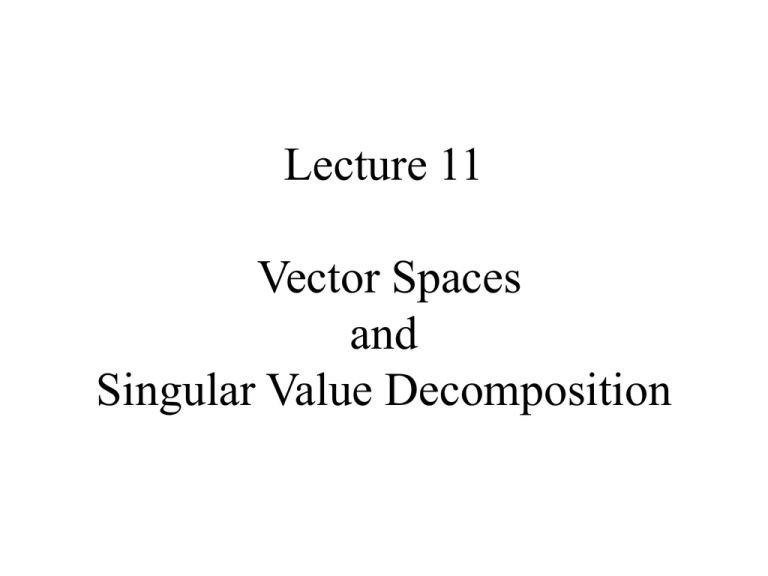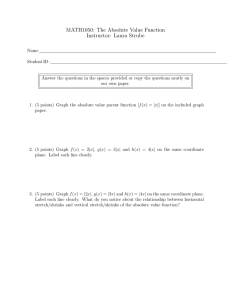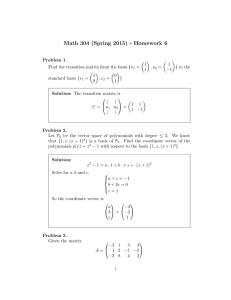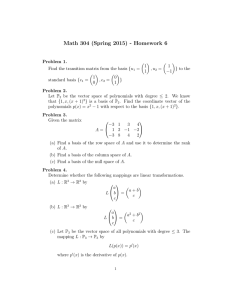Lecture 11 Vector Spaces and Singular Value Decomposition
advertisement

Lecture 11 Vector Spaces and Singular Value Decomposition Syllabus Lecture 01 Lecture 02 Lecture 03 Lecture 04 Lecture 05 Lecture 06 Lecture 07 Lecture 08 Lecture 09 Lecture 10 Lecture 11 Lecture 12 Lecture 13 Lecture 14 Lecture 15 Lecture 16 Lecture 17 Lecture 18 Lecture 19 Lecture 20 Lecture 21 Lecture 22 Lecture 23 Lecture 24 Describing Inverse Problems Probability and Measurement Error, Part 1 Probability and Measurement Error, Part 2 The L2 Norm and Simple Least Squares A Priori Information and Weighted Least Squared Resolution and Generalized Inverses Backus-Gilbert Inverse and the Trade Off of Resolution and Variance The Principle of Maximum Likelihood Inexact Theories Nonuniqueness and Localized Averages Vector Spaces and Singular Value Decomposition Equality and Inequality Constraints L1 , L∞ Norm Problems and Linear Programming Nonlinear Problems: Grid and Monte Carlo Searches Nonlinear Problems: Newton’s Method Nonlinear Problems: Simulated Annealing and Bootstrap Confidence Intervals Factor Analysis Varimax Factors, Empirical Orthogonal Functions Backus-Gilbert Theory for Continuous Problems; Radon’s Problem Linear Operators and Their Adjoints Fréchet Derivatives Exemplary Inverse Problems, incl. Filter Design Exemplary Inverse Problems, incl. Earthquake Location Exemplary Inverse Problems, incl. Vibrational Problems Purpose of the Lecture View m and d as points in the space of model parameters and data Develop the idea of transformations of coordinate axes Show how transformations can be used to convert a weighted problem into an unweighted one Introduce the Natural Solution and the Singular Value Decomposition Part 1 the spaces of model parameters and data what is a vector? algebraic viewpoint a vector is a quantity that is manipulated (especially, multiplied) via a specific set of rules geometric viewpoint a vector is a direction and length in space what is a vector? algebraic viewpoint columna vector is a quantity that is manipulated (especially, multiplied) via a specific set of rules geometric viewpoint a vector is a direction and length in space in our case, a space of very high dimension S(d) S(m) d m3 m d3 forward problem d = Gm maps an m onto a d maps a point in S(m) to a point in S(d) Forward Problem: Maps S(m) onto S(d) d m3 m d3 inverse problem m = G-gd maps a d onto an m maps a point in S(m) to a point in S(d) Inverse Problem: Maps S(d) onto S(m) d m3 m d3 Part 2 Transformations of coordinate axes coordinate axes are arbitrary given M linearly-independent basis vectors m(i) we can write any vector m* as ... don’t span space span space d m3 m3 ... as a linear combination of these basis vectors ... as a linear combination of these basis vectors components of m* in new coordinate system mi*’ = αi might it be fair to say that the components of a vector are a column-vector ? matrix formed from basis vectors Mij = vj(i) transformation matrix T transformation matrix T same vector different components Q: does T preserve “length” ? (in the sense that mTm = m’Tm’) A: only when T T= -1 T transformation of the model space axes d = Gm = GIm = [GTm-1] [Tmm] = G’m’ d = Gm d = G’m’ same equation different coordinate system for m transformation of the data space axes d’ = Tdd = [TdG] m = G’’m d = Gm d’ = G’’m same equation different coordinate system for d transformation of both data space and model space axes d’ = Tdd = [TdGTm-1] [Tmm] = G’’’m’ d = Gm d’ = G’’’m’ same equation different coordinate systems for d and m Part 3 how transformations can be used to convert a weighted problem into an unweighted one when are transformations useful ? remember this? when are transformations useful ? remember this? massage this into a pair of transformations mTWmm Wm T =D D or ½ ½ ½T ½ Wm=Wm Wm =Wm Wm OK since Wm symmetric mTWmm = mTDTDm = [Dm] T[Dm] Tm when are transformations useful ? remember this? massage this into a pair of transformations eTWee We=We½We½=We½TWe½ OK since We symmetric eTWee = eTWe½TWe½e = [We½m] T[We½m] Td we have converted weighted least-squares into unweighted least-squares minimize: E’ + L’ = e’Te’ +m’Tm’ steps 1: Compute Transformations Tm=D=Wm½ and Te=We½ 2: Transform data kernel and data to new coordinate system G’’’=[TeGTm-1] and d’=Ted 3: solve G’’’ m’ = d’ for m’ using unweighted method 4: Transform m’ back to original coordinate system m=Tm-1m’ steps extra work 1: Compute Transformations Tm=D=Wm½ and Te=We½ 2: Transform data kernel and data to new coordinate system G’’’=[TeGTm-1] and d’=Ted 3: solve G’’’ m’ = d’ for m’ using unweighted method 4: Transform m’ back to original coordinate system m=Tm-1m’ steps 1: Compute Transformations Tm=D=Wm½ and Te=We½ to allow simpler solution method 2: Transform data kernel and data to new coordinate system G’’’=[TeGTm-1] and d’=Ted 3: solve G’’’ m’ = d’ for m’ using unweighted method 4: Transform m’ back to original coordinate system m=Tm-1m’ Part 4 The Natural Solution and the Singular Value Decomposition (SVD) Gm = d suppose that we could divide up the problem like this ... Gm = d only mp can affect d since Gm0 =0 Gm = d Gmp can only affect dp since no m can lead to a d0 determined by a priori information determined by data determined by mp not possible to reduce natural solution determine mp by solving dp-Gmp=0 set m0=0 what we need is a way to do Gm = d Singular Value Decomposition (SVD) singular value decomposition UTU=I and VTV=I suppose only p λ’s are non-zero suppose only p λ’s are non-zero only first p columns of U only first p columns of V UpTUp=I and VpTVp=I since vectors mutually pependicular and of unit length UpUpT≠I and VpVpT≠I since vectors do not span entire space The part of m that lies in V0 cannot effect d since T Vp V0=0 so V0 is the model null space The part of d that lies in U0 cannot be affected by m since ΛpVpTm is multiplied by Up and U0 UpT =0 so U0 is the data null space The Natural Solution The part of mest in V0 has zero length The error has no component in Up computing the SVD determining p use plot of λi vs. i however case of a clear division between λi>0 and λi=0 rare (A) j (B) 4 3 λλi i 2 S i i 1 0 (C) j 2 4 6 8 10 12 14 i index number ,i (D) 16 18 20 16 18 20 p 2.5 2 i λi 1.5 S i 1 0.5 0 2 4 6 8 p? 10 12 i 14 index number, i Natural Solution (A) (B) = G m dobs mtrue (mest)DML (mest)N resolution and covariance resolution and covariance large covariance if any λp are small Is the Natural Solution the best solution? Why restrict a priori information to the null space when the data are known to be in error? A solution that has slightly worse error but fits the a priori information better might be preferred ...



